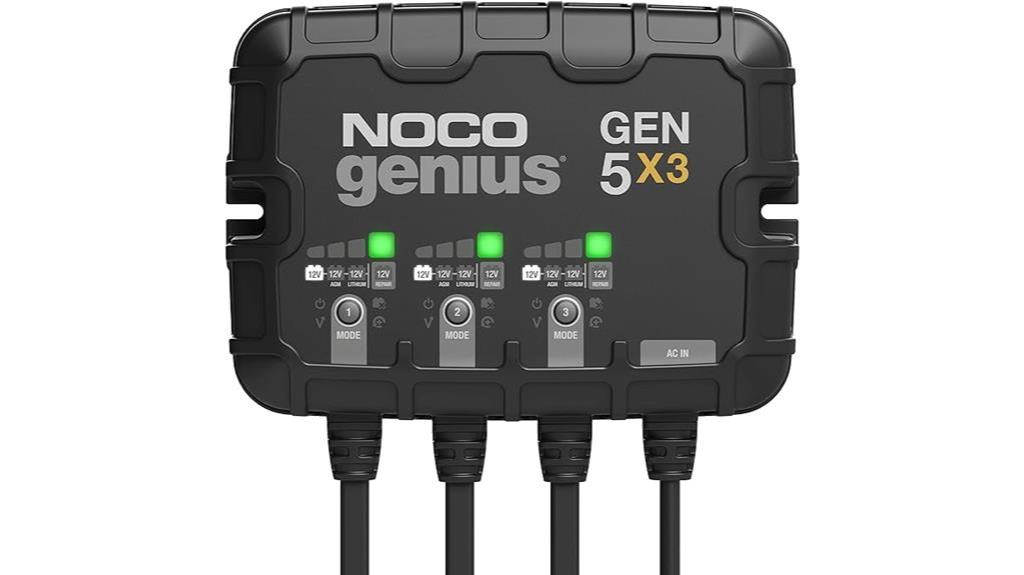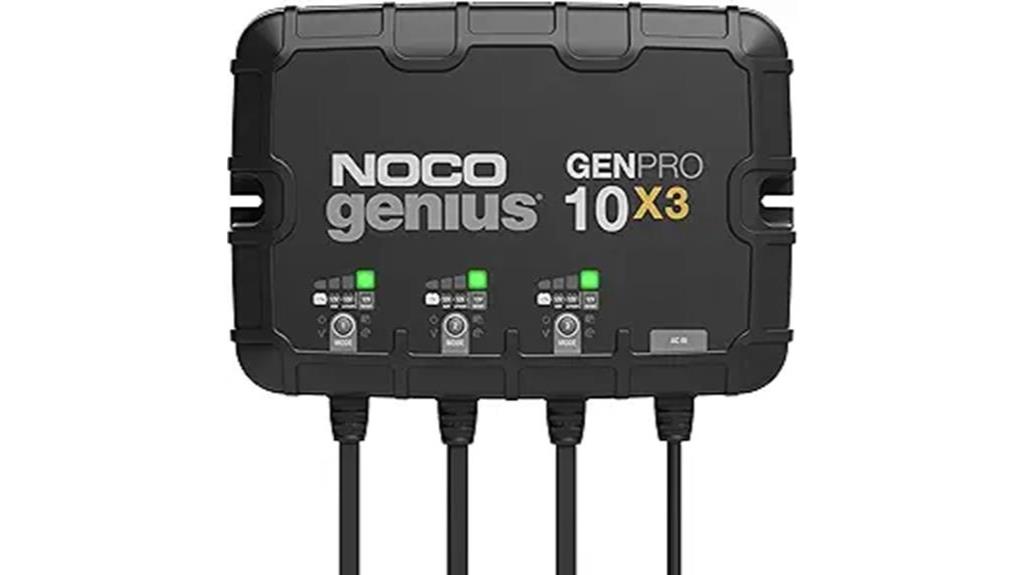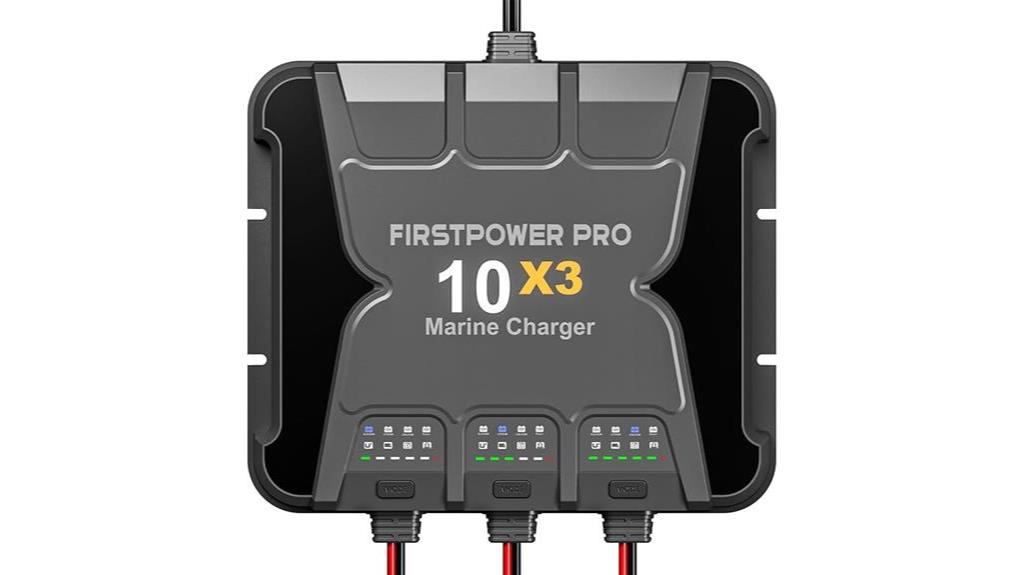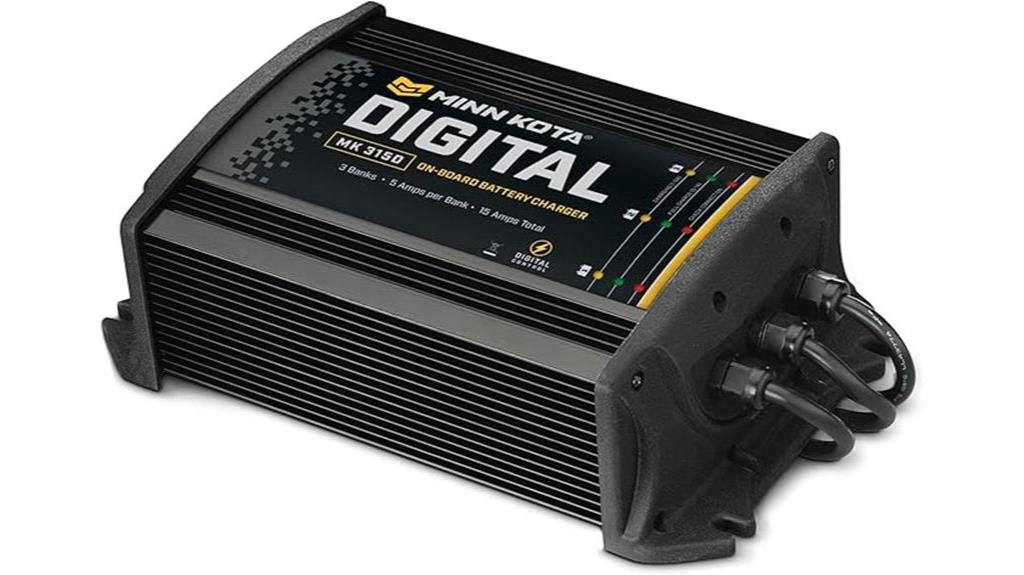When you're powering up your adventures, the right 3-bank onboard marine battery charger matters. The top picks include the NOCO Genius GEN5X3, which charges three batteries simultaneously and supports multiple battery types. The NOCO GENPRO10X3 offers user-friendly installation, while the ProMariner ProSport HD guarantees efficient charging with its microprocessor control. If you need higher capacity, consider the 30A 12V Waterproof charger. Finally, the Johnson Outdoors MinnKota MK 315D is perfect for trolling motors. Each of these chargers promises reliability and performance for your marine escapades, and there's more to discover about their unique features.
NOCO Genius GEN5X3 Smart Marine Battery Charger

If you're a boat owner looking for a reliable solution to keep your marine batteries charged and ready, the NOCO Genius GEN5X3 Smart Marine Battery Charger is an excellent choice. This compact 3-bank charger delivers 15A of power, efficiently charging up to three batteries simultaneously. It supports various battery types, including lead-acid and lithium-ion, with selectable modes to suit your needs. I appreciate that it can even charge batteries as low as 1-volt, making it incredibly versatile. Plus, its waterproof design and user-friendly installation make it a breeze to set up. With a 3-year warranty and strong customer support, I feel confident knowing my batteries will always be ready for my next adventure on the water.
Best For: Boat owners seeking a reliable and versatile charging solution for multiple types of marine batteries.
Pros:
- Compact and efficient design allows for easy installation and operation in limited spaces.
- Versatile charging modes support various battery types, ensuring compatibility with different systems.
- Durable waterproof construction provides protection against harsh marine environments.
Cons:
- Higher initial cost compared to basic chargers may deter budget-conscious buyers.
- Limited to 12V batteries, which may not suit users with other voltage requirements.
- May require additional accessories for certain installation setups, leading to extra costs.
NOCO Genius GENPRO10X3 Smart Marine Battery Charger

The NOCO Genius GENPRO10X3 Smart Marine Battery Charger is ideal for boaters and RV enthusiasts who need a reliable and efficient way to charge multiple batteries. With its 3-bank design, it independently charges up to three 12-volt batteries at 10 amps each, making it perfect for various applications. I love that it supports lead-acid and lithium-ion batteries, plus it includes selectable charging modes for added versatility. Its robust waterproof design and integrated thermal sensor guarantee safe charging in harsh environments. The installation is a breeze, allowing for mounting in any direction. With a 3-year warranty and excellent user feedback, I'm confident this charger will meet your needs and keep your adventures powered up.
Best For: Boaters and RV enthusiasts seeking a reliable and efficient solution to charge multiple batteries simultaneously.
Pros:
- Versatile compatibility with both lead-acid and lithium-ion batteries, accommodating various needs.
- Robust waterproof design with an IP68 rating, ensuring durability in harsh marine environments.
- User-friendly installation allows for mounting in any direction, making setup simple and convenient.
Cons:
- May be overkill for users with only one or two batteries, as it is designed for three banks.
- Initial cost might be higher compared to simpler chargers.
- Some users may find the force mode for dead battery recovery unnecessary for their typical usage.
3 Bank Marine Battery Charger (30A, 12V Waterproof)

Designed for avid boaters and marine enthusiasts, the 3 Bank Marine Battery Charger (30A, 12V Waterproof) is perfect for those who need reliable power management for multiple batteries. This powerhouse charges three batteries simultaneously, whether they're SLA, AGM, Lithium, or deep-cycle types. I love its IP68 waterproof rating, ensuring durability in harsh marine environments. The integrated thermal sensor adjusts charging based on temperature, preventing any over- or under-charging mishaps. Plus, its advanced diagnostics keep me informed about battery health, showing alerts for issues like over-voltage or bad batteries. With a three-year warranty and positive user reviews citing effective charging and easy installation, it's a solid choice for anyone looking to enhance their marine adventures.
Best For: Those seeking a reliable and durable battery charger for multiple marine batteries in challenging environments.
Pros:
- Effective charging and repair capabilities for various battery types.
- Compact design and easy installation, praised by users.
- IP68 waterproof rating ensures durability in harsh marine conditions.
Cons:
- Some users reported issues with overheating during use.
- Mixed reviews on customer service responsiveness.
- Lack of hardwire eyelets and unclear waterproof usage instructions caused confusion.
ProMariner ProSport HD Waterproof Marine Battery Charger (20 Amp, 3 Bank)

For boat owners seeking a reliable and efficient charging solution, the ProMariner ProSport HD Waterproof Marine Battery Charger stands out with its powerful 20 Amp, 3 Bank capability. This microprocessor-controlled charger uses ProMar Digital Technology for fast and precise charging, ensuring that every battery gets the power it needs. I appreciate the heavy-duty design that keeps the unit cool during operation, which adds to its longevity.
The expanded LED display makes monitoring the charging status easy, with clear indicators for each battery's condition. Customers generally rate it highly, noting its fast charging and responsive customer service. However, be cautious about warranty claims. Overall, I highly recommend this charger for anyone serious about maintaining their boat's batteries.
Best For: The ProMariner ProSport HD Waterproof Marine Battery Charger is best for boat owners looking for a dependable and efficient solution to charge multiple batteries simultaneously.
Pros:
- Fast and precise charging due to ProMar Digital Technology, enhancing battery performance.
- User-friendly LED display provides clear status indicators for each battery's condition.
- Responsive customer service with quick replacements reported for warranty claims.
Cons:
- Some users experienced issues with warranty claims and product defects.
- Concerns regarding water damage potentially voiding the warranty.
- A few customers reported difficulties with the warranty process.
Johnson Outdoors MinnKota MK 315D On-Board Battery Charger

When you need a reliable charging solution for your 24-volt trolling motor setup, the Johnson Outdoors MinnKota MK 315D On-Board Battery Charger stands out with its three banks and 5 amps per bank. This charger efficiently recharges two 12-volt batteries for your trolling motor and one for starting, ensuring everything's ready for your next adventure. I appreciate its multi-stage charging and automatic temperature compensation, which helps prevent overcharging. The corrosion-resistant design holds up well in saltwater, making it perfect for my coastal trips. Plus, the LED indicators keep me informed about the charging status. With a three-year warranty and solid customer support, I feel confident about my investment in this durable and effective charger.
Best For: Individuals with 24-volt trolling motors who need a reliable and efficient battery charging solution.
Pros:
- Multi-stage charging ensures optimal battery health and prevents overcharging.
- Corrosion-resistant design withstands harsh saltwater conditions, making it ideal for coastal use.
- LED indicators provide clear status updates on the charging process.
Cons:
- The charger is larger and heavier than some users might expect.
- Some users report blown fuses, which may require attention.
- Installation may require additional effort for those unfamiliar with electrical systems.
Factors to Consider When Choosing 3-Bank Onboard Marine Battery Chargers
When you're choosing a 3-bank onboard marine battery charger, consider several key factors that impact performance and usability. You'll want to evaluate the charging capacity and efficiency, guarantee compatibility with your battery types, and check how easy it is to install. Don't forget to assess durability, waterproof ratings, and temperature management features to keep your charger running smoothly in various conditions.
Charging Capacity and Efficiency
Efficiency is essential in choosing the right 3-bank onboard marine battery charger, as it directly impacts your charging experience and battery lifespan. Look for chargers with higher amperage per bank, ideally 10A or more, to guarantee faster charging times for multiple batteries simultaneously. A charger that can handle low voltage recovery, starting from as low as 1 volt, is critical for reviving deeply discharged batteries, saving you time and hassle on the water.
Additionally, select chargers with integrated thermal sensors. These sensors automatically adjust charging rates based on ambient temperature, enhancing overall efficiency and promoting battery health. Multi-stage charging technology is another significant feature, as it optimizes battery performance and extends lifespan by preventing overcharging and maintaining proper voltage levels.
Compatibility With Battery Types
Choosing the right 3-bank onboard marine battery charger goes beyond just efficiency; compatibility with various battery types is equally important. When you're selecting a charger, make certain it can handle multiple battery types, including lead-acid (flooded, gel, AGM), lithium-ion (LiFePO4), and calcium batteries. This flexibility allows you to maintain different batteries for your boating, RV, or other adventures.
Look for chargers that offer selectable modes tailored for different battery chemistries. These modes optimize charging and maintenance, guaranteeing your batteries stay in peak condition. It's also wise to choose a charger that can safely charge batteries as low as 1 volt. Some models even include a force mode specifically designed for reviving dead batteries below this threshold.
Additionally, advanced chargers often come with integrated thermal sensors. These sensors adjust the charging process based on ambient temperature, which is vital for maintaining battery health across various types. By prioritizing compatibility with a wide range of battery types, you enhance your versatility and guarantee your adventures are powered without a hitch.
Installation and Mounting Ease
Installing a 3-bank onboard marine battery charger shouldn't feel like an intimidating task. To make things easier, look for chargers with a simplified mounting system that allows installation in any orientation, even upside-down. This flexibility maximizes space and accessibility on your boat.
It's essential to ascertain the charger comes with self-tapping screws and user guides, which can streamline your installation process. You'll appreciate chargers featuring integrated anti-vibration backing, as they minimize shock, vibration, and noise during operation, enhancing durability over time.
When selecting a charger, consider its dimensions and weight. You want something that can be easily mounted in your desired location without compromising structural integrity or stability. Also, verify that the charger boasts an IP68 waterproof rating. This feature guarantees reliable performance in harsh marine environments, making installation worry-free.
Durability and Waterproof Ratings
When you're out on the water, the last thing you want to worry about is whether your battery charger can handle the harsh marine environment. To guarantee reliability, look for a charger with a waterproof rating of at least IP68. This rating means the device is fully sealed and can withstand immersion in water, perfect for those unexpected splashes.
Durability is equally important. Select chargers made from robust, corrosion-resistant materials, especially since saltwater exposure can wreak havoc on less sturdy options. Additionally, consider chargers with integrated anti-vibration features. These can safeguard internal components from the shocks and vibrations common on boats, extending the life of your charger.
Multi-stage charging technology is another crucial factor. This feature not only enhances battery performance but also helps prevent overheating and overcharging, contributing to the overall longevity of the charger. Finally, check if the product has undergone extensive life cycle testing. This guarantees that it can perform reliably in real-world conditions over an extended period. By focusing on these durability and waterproof ratings, you can enjoy your adventures without worrying about your charger.
Temperature Management Features
Alongside durability and waterproof ratings, temperature management features play a significant role in the performance of 3-bank onboard marine battery chargers. These chargers often utilize integrated thermal sensors to adjust charging rates based on the ambient temperature, which helps prevent overheating and guarantees peak charging performance.
When selecting a charger, look for models that automatically adjust their output to compensate for temperature variations. This capability can prevent overcharging in hot conditions and undercharging in cold environments, ultimately enhancing battery lifespan and performance.
Some chargers come equipped with automatic temperature compensation, which modifies the voltage output according to the temperature of the batteries being charged. This not only improves charging efficiency but also reduces stress and potential damage that can occur from extreme temperature fluctuations during the charging process.
Moreover, chargers with advanced temperature management technologies frequently include diagnostic features that alert you to potential issues like overheating or battery malfunctions. By prioritizing temperature management, you can guarantee your marine batteries are charged efficiently and effectively, enhancing your adventures on the water.
Warranty and Support Options
Before making a purchase, it's essential to dig into the warranty and support options offered with 3-bank onboard marine battery chargers. A typical warranty lasts around three years, giving you peace of mind against manufacturing defects. This coverage can be a significant factor in your decision, as it safeguards your investment.
Additionally, many chargers feature a return policy, often allowing a 30-day window for returns if the product doesn't meet your expectations. This flexibility can be invaluable if you encounter any issues right after purchase.
Don't overlook the importance of customer support services. Some brands provide responsive assistance for warranty claims and technical issues, making your experience smoother if problems arise. Before committing, take the time to read customer feedback regarding warranty experiences; some users report difficulties with claims or product defects, which can be a red flag.
Lastly, make sure you understand the warranty terms, including any conditions that might void it, like water damage or improper usage. By considering these factors, you'll make a well-informed choice when selecting the right charger for your adventures.
Price and Value Comparison
Understanding warranty and support options sets the stage for evaluating price and value in 3-bank onboard marine battery chargers. When comparing prices, consider the charging capacity of each bank. Chargers with higher amp ratings, like 10A per bank, can considerably enhance overall efficiency and reduce charging time compared to lower-rated models.
Next, examine waterproof ratings, such as IP68. Higher durability typically translates to better long-term value, even if the upfront cost is steeper. A charger that lasts longer can save you money in the long run.
Don't overlook warranty length and customer service responsiveness. A solid warranty and dependable support can shield you from unexpected repair or replacement expenses. Additionally, multi-stage charging technology is a feature of many higher-priced models; this technology can improve battery performance and lifespan, justifying the investment.
Frequently Asked Questions
How Do I Install a 3-Bank Onboard Marine Battery Charger?
To install a 3-bank onboard marine battery charger, first, choose a suitable location on your boat, ensuring it's dry and well-ventilated. Then, disconnect the batteries. Connect the charger's positive and negative leads to each battery, making sure to follow the manufacturer's instructions. Secure the charger with screws, and connect it to your boat's power supply. Finally, double-check all connections, reconnect the batteries, and plug in the charger to complete the installation.
Can These Chargers Be Used With Different Battery Types?
Think of your charger as a versatile chef in a kitchen, capable of whipping up meals for different diets. Yes, you can use these chargers with various battery types, like lead-acid, AGM, or gel batteries. Just make sure to check the charger's specifications and compatibility. It's like ensuring your chef has the right ingredients for each dish. With the right setup, you'll keep all your batteries healthy and ready for action.
What Maintenance Is Required for Marine Battery Chargers?
Maintaining your marine battery charger is essential for peak performance. Regularly check the connections for corrosion or wear, and clean them as needed. Inspect the charger's housing for any signs of damage. Keep the ventilation areas clear to prevent overheating. Test the charger periodically to verify it's functioning properly. If you notice any unusual sounds or lights, investigate immediately. Following these steps will help extend the life of your charger and guarantee reliable power.
Are There Safety Features in These Chargers?
Yes, there are several safety features in marine battery chargers that you should look for. These chargers often include overcharge protection to prevent battery damage, short circuit protection to safeguard your equipment, and thermal protection to avoid overheating. Additionally, many models have reverse polarity protection to guarantee you don't accidentally connect the cables incorrectly. With these features, you can charge your batteries with confidence, keeping both you and your equipment safe during every adventure.
How Do I Troubleshoot Charging Issues With My Onboard Charger?
To troubleshoot charging issues with your onboard charger, start by checking all connections for corrosion or looseness. Confirm the charger's power source is working; you can test it with a multimeter. Inspect the fuses for any blown ones and replace them if necessary. Verify that your batteries are healthy and fully seated. If the problem persists, consult the user manual or consider reaching out to a professional for further assistance.
Wrapping Up
When it comes to choosing the right 3-bank onboard marine battery charger, you'll want to evaluate efficiency, durability, and ease of use. Each option on this list offers unique features that cater to different needs, ensuring your adventures stay powered and worry-free. So whether you're cruising the coastline or fishing in remote waters, investing in a quality charger means you're safeguarding your battery life, enhancing your experience, and empowering your journey on the water.
